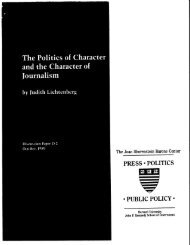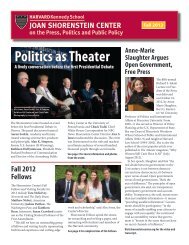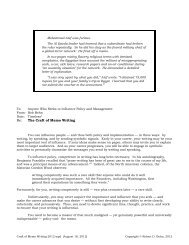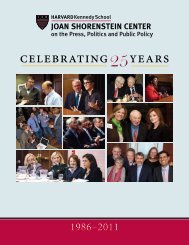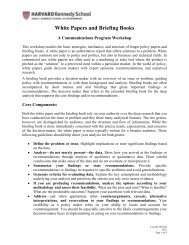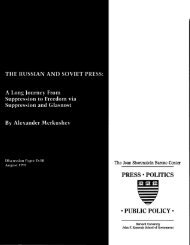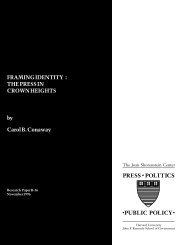Anatomy of a Secret - Harvard Kennedy School
Anatomy of a Secret - Harvard Kennedy School
Anatomy of a Secret - Harvard Kennedy School
Create successful ePaper yourself
Turn your PDF publications into a flip-book with our unique Google optimized e-Paper software.
In the end, the Times decided that illegality trumped national security concerns in the<br />
Stellar Wind story, but it was one <strong>of</strong> the more difficult calls that a newspaper has ever<br />
had to make with merit on both sides <strong>of</strong> the question. The controversy has never ended.<br />
In May <strong>of</strong> 2012 the Supreme Court agreed to hear legal challenges to the 2008 FISA Act<br />
Amendment, but even if the court upholds the 2008 law, it may not answer questions<br />
concerning NSA’s actions prior to that amendment.<br />
CONCLUSION<br />
The New York Times ran into a fire <strong>of</strong> criticism over their handling <strong>of</strong> the NSA story,<br />
and there were the usual threats <strong>of</strong> prosecution. But the Bush administration never<br />
followed through on the threats. I asked General Michael Hayden who was head <strong>of</strong><br />
NSA, and then later CIA, why the government had not taken The New York Times to<br />
court. “ Our overall judgment was not to go in that direction,” he said. 59<br />
As governments struggle to keep their secrets, the press charges that government<br />
secrecy is obsessive. A CIA public affairs <strong>of</strong>ficer, Bill Harlow, once said that there is<br />
much government angst over leaks and press complaints about over-classification, “and<br />
they’re both right. They are all reasonable people, but coming to common ground on the<br />
issue is difficult.” 60<br />
How newspapers ferret out classified secrets is always <strong>of</strong> concern to governments.<br />
But for every direct leak, such as Daniel Ellsberg handing The New York Times the<br />
Pentagon Papers, there are dozens more where the secret is “assembled like a Lego<br />
skyscraper, brick by brick....Often the sources who help the reporters doing it don’t even<br />
realize they have contributed a brick or two in the construction,” wrote Robert Kaiser, a<br />
former managing editor <strong>of</strong> The Washington Post. Typically, many <strong>of</strong> these sources don’t<br />
know the whole story themselves, “just a sliver <strong>of</strong> it. A good reporter can spend weeks<br />
or months on a single story looking for those slivers or bricks,” Kaiser wrote. 61<br />
In the case <strong>of</strong> Stellar Wind, reporters Seymour Hersh, James Risen and Eric Lichtblau<br />
may have had a tip that started them thinking, but their stories were built brick by brick<br />
as they teased the information out <strong>of</strong> many different sources.<br />
17



